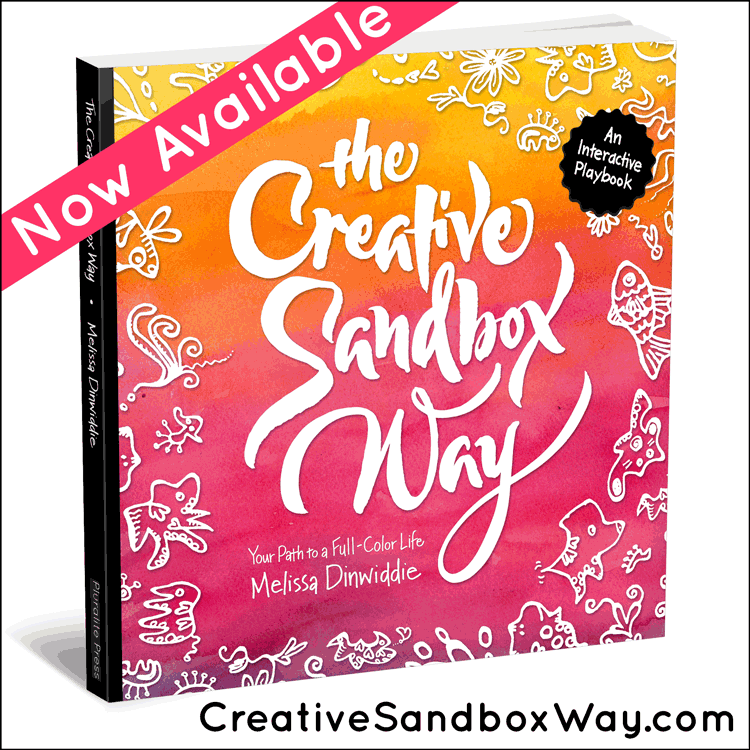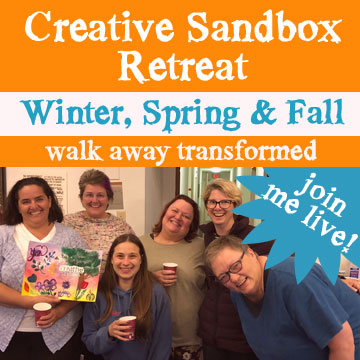
 It’s another listener question episode today!
It’s another listener question episode today!
I love answering listener questions, and my favorite ways to get them is as voicemail messages at livecreativenow.com/questions, and in 5-star iTunes reviews.
I learned recently, though, that iTunes only shows me reviews from US-based iTunes users.
So if you live in any other country, I won’t ever see your review — or the question inside of it — unless you let me know you left it, and let me know what country you’re in!
The best way to do that is to leave your review, including your question, and then go to livecreativenow.com/questions and also record your question in a free voicemail, letting me know which country you’re calling from.
If for some reason you don’t want your voice on the podcast, then of course you can always email me instead.
Okay, now that that’s out of the way, let’s get on with today’s question from Maria, who left the following in a 5-star iTunes review. It starts with her review:
Melissa is my favorite because she is very not lecturey, and her podcasts are so easy and fun to listen to!
I thought I was creative, but after listening to Melissa, I felt like she was the honest voice in my heart, the voice that talks about all the things I’ve been afraid to face.
I didn’t even know there were other people out there “caring too much” to create! WOW!
I’m excited to hear more! I LOVE MELISSA!!!
[Thank you, Maria! That made my day! 🙂 ]
Melissa, if you’re reading this, could you please talk about: How to get permission to make crap when my parents/people are constantly watching to see if I can make a living as an artist?
I feel like I’m not allowed to make crap because crap won’t sell, and I’ll get lots of “I told you so!” ?
So right now I feel frozen and can’t make anything, any advice?
Do I have advice? You know I can talk for hours about just about anything.
You Are the Only One Who Can Grant Permission
The first thing I want to say is that the only person who can give you permission to make crap is you. And you have to take that permission.
You have to own your entitlement to creative play.
Now, I’m not saying this is easy. It’s not. At least it wasn’t for me.
It has been an ongoing practice.
You set the intention that there is no wrong (Creative Sandbox Manifesto rule #1).
And you set the intention to think process, not product (Creative Sandbox Manifesto rule #2).
And you make something. Maybe you make something intentionally bad!
Then you apply my Golden Formula: self-awareness + self-compassion = the key to everything good. (Click to tweet.)
Self-awareness means noticing. How does it feel when you create in this way? What feelings are coming up?
Then, regardless of the feelings, you respond with self-compassion.
What Is Self-Compassion, Anyway?
Dr. Kristin Neff, author of Self-Compassion: The Proven Power of Being Kind to Yourself (aff link), and the world’s foremost researcher on self-compassion, has found three components to self-compassion:
- Mindfulness: The ability to be in present time; to observe, in a nonjudgey way, your surroundings, sensations, and reactions, without being swept away by them.
- Common humanity: Understanding that you are human, forgiving yourself for being human, and understanding that you are not the only person every to experience this kind of suffering.
- Self-kindness: Responding gently and kindly to yourself, the way you would to a beloved friend or a child.
When you practice allowing yourself to make crap, some of the feelings that might come up are disgust (“OMG, that’s so awful!”), frustration (“I’m never going to make anything worthy!”), guilt (actually false guilt — “How can I create this drivel, when I’ve trained for years to create X?” See episode 64 for more on the subject of false guilt), shame (“I’m a terrible person.”), fear (“Nobody will ever like or accept me.”)
Those sound a lot like gremlins talking.
Never take direction from your gremlins. (Click to tweet.)
Never Take Direction from Your Gremlins
Maybe other feelings come up. It doesn’t matter. Whatever feelings come up, whatever gremlins start yammering at you, do not let them stop you!
This is critical!
Remember, gremlins exist to keep you safely inside your comfort zone. And letting yourself make crap is, for most of us, well outside your comfort zone.
But the only way to discover what you’re capable of, and to express your full potential as a creator, is to let yourself make crap! (Click to tweet.)
So practice that. Practice setting the intention, noticing how it feels, responding with self-compassion, and not letting the gremlins stop you.
Even if what comes out seems horrible!
Remember: we need the crap to fertilize the good stuff. (Click to tweet.)
The Crap to Gold Ratio
In a lot of creative fields — photography, songwriting, to name just a couple — it’s no unusual to expect 90% of what you create to be crap! That means only 10% will be gold.
This is okay! This is perfectly normal!
Sheesh, believe me, I write a lot of crappy stuff to get to a blog post that feels good enough to publish. If I let my fear of creating crap stop me, I’d never write a darn thing.
In fact, that is exactly what happened back in 1994, when, for a brief time, I decided I was going to be a writer.
Now, you know me now as a writer, because I write all the time on my blog, and other blogs, but back in 1994, I decided that I was going to be a professional, full-time, write-for-a-living writer.
My expectations were so high, and the pressure felt so intense, that nothing I created felt any good at all. It all felt like crap, and back then I did not give myself permission to create crap!
So guess what. I created nothing.
Zip. Zero. Nada.
For sixteen years!
Is that really what you want? I don’t think so.
Okay, so that’s the first thing I want to say, Maria.
They Don’t Like It? Don’t Show It To Them!
The second thing I want to share is a lesson from an improv teacher of mine, Joshua Raoul Brody, who teaches musical improv for BATS Improv — making up songs on the fly.
A lot of improvisors who take his classes feel very insecure about their voices. Maybe their whole lives they’ve been told they can’t sing.
So Joshua says, “If somebody doesn’t like the way you sing, don’t sing for them!”
If your parents’, or anybody else’s, disapproval is paralyzing, stop showing your work to them!
The Purpose of Making Crap
Okay, now, the third thing I want to say is in regard to your statement, “I feel like I’m not allowed to make crap because crap won’t sell, and I’ll get lots of ‘I told you so!'”
I have two points about this statement.
First, we allow ourselves to make crap in order to free ourselves up. To open the channel to our richest, deepest, most authentic creativity.
Allowing yourself to make crap is the only way you access your best stuff! (Click to tweet.)
Also, if we never let ourselves make anything bad, we never start. We never learn what needs improving. We never discover new ideas to follow.
The crap we create is not trash — it’s manure. We need the crap to fertilize the good stuff. (Click to tweet.)
If you feel that everything you make has to be for sale, that is a fast route to either perfectionist paralysis (if you choke up, like I did with writing back in 1994), or burnout (if you just repeat what you’ve already done ad nauseum).
You MUST give yourself sacred Creative Sandbox time, where you create purely for the joy of it. NOT for money.
This is critical!
I know not everybody listening is interested in making money from your creative efforts, but if you are, it is critical to make sure you dedicate some time to Creative Sandbox play every week, ideally every day. Otherwise you will burn out — guaranteed.
When you’re in the Creative Sandbox and you find yourself thinking, “Oh, geez, what am I doing? This will never sell!” remind yourself that this is Creative Sandbox time. That it’s not about making money — it’s about freeing up your creativity and feeling more alive!
And fertilizing the good stuff.
If you let yourself do that, that will eventually lead to creating stuff that will bring in the money.
Assumption Paralysis
The second point I have about your statement that “crap won’t sell,” is that this is a huge assumption.
You don’t actually know whether it will sell or not!
And though your focus when you’re in the Creative Sandbox must be on play and freedom and joy — not “will this make money?” — what emerges from your time in the Creative Sandbox may end up surprising you in its sellability.
But unless you give yourself Creative Sandbox time, where you don’t think about making money at all, you will never know.
I have a practice of sharing what comes out of my Creative Sandbox sessions, whether I’m pleased with what I’m working on, or disgusted by it. I share the process regardless.
More than once I have posted a painting to Instagram and Facebook, and thought to myself, “Well, that’s a piece of crap. I am going to gesso over that painting tomorrow!” only to have someone ask to buy that very painting!
One person’s crap is another person’s treasure. (Click to tweet.)
The Power of Perception
This is one of the reasons I’m such a big believer in sharing work before you feel ready.
Our perceptions are so distorted by the gremlin-tinted glasses we’re wearing. We only see what we don’t like about what we create. Where it falls short of the vision.
But other people don’t see that!
Other people see your work for what it is. You see your work for what it isn’t. (Click to tweet.) (Hat tip to calligrapher and teacher Peter Thornton, from whom I first heard a variation on this phrase.)
You only see the lack.
When I started sharing in-process work on social media, it changed my life, because it helped me see my art, my writing, my music, through the lenses of other people’s glasses, instead of my gremlin glasses.
It helped me take off my gremlin glasses and put on neutral glasses for awhile.
That helped me have more appreciation and compassion for my work, and for me as the imperfect creator, aiming for an ideal, platonic vision, and falling short.
Detaching from Frozen Needs for Approval
In order for me to see through other people’s glasses, though, I had to unhook myself from the need for other people’s approval and praise.
There’s a huge difference between putting something out there with the energy of “Do you like this? Is it okay? Is it good enough?” and the energy of sharing. Truly sharing with an open heart and open mind, unattached from the outcome.
Giving a gift to the world, not seeking praise or validation.
Patti Digh, best-selling author and creator of Life Is A Verb Camp (which you should totally come to — it’s amazing! And I’m going to be speaking there this year!), calls this “making a strong offer.”
Strong Offers
That’s a concept from the world of improv, where an offer is anything you do or say that fills in a piece of the world or situation you’re creating in a scene.
I might hold my hands together, palms up, look down at them, and say, “Oh, Jim, honey, it’s the most beautiful necklace I’ve ever seen! Thank you — what an incredible anniversary gift!”
That’s an offer, and it contains a lot of information for my partner: he now knows that his name is Jim, that he just gave me a necklace, and that we’re celebrating an anniversary.
But what happens next, what my partner does with this offer, is out of my control.
I may have it in my head that we’re a married couple, celebrating our first anniversary at a restaurant on the beach in Kona, Hawaii.
But my partner may respond with something that totally negates my idea. He may say, “Well, Sally, I know it’s been ten years since we first cheated on our spouses together, and you’ve been wanting me to leave my wife ever since, so the least I could do to show you how much I love you is to buy you some expensive jewelry and take you on this African safari.”
Clearly the scene that he has now set us in with his offer is different from the one I had in my head. And if I hold onto my idea that we’re a married couple celebrating our first anniversary in Hawaii, the scene goes nowhere.
In fact, it implodes, fast.
Make the Offer, Then Let Go
In order for improv to work, each improvisor has to make an offer and then let go of the outcome. You have to be open to accepting whatever comes next, and rolling from there.
Putting creative work out into the world is like this. Make the offer — post your work online, enter that competition, apply to teach at the conference — then let go.
Your job is to make a strong offer. Period.
The outcome is out of your hands, so practice letting go of it.
Summing Up
So, Maria, the upshot is:
- You are the only one who can grant you permission. And that takes practice.
- If your parents (or anyone else) don’t like your work, don’t show it to them.
- Letting yourself play in the Creative Sandbox — which includes allowing yourself the freedom to create crap — is the only way you’ll ever access your richest, deepest, most original, most creative work. It’s also how we get better at anything — we need the crap to fertilize the good stuff.
- One person’s crap is another person’s treasure. What you judge to be crap, somebody else may totally love!
- Your job is to make strong offers and let go of the outcome.
- It’s very simple… but not easy at all. I know, because this is the same exact journey I’ve been on for the past several years.
I can tell you, though, that it gets easier with practice to let go and play in the Creative Sandbox.
I was the poster child for perfectionist paralysis, so if I can do it, you can, too.
It all starts with the decision to do it.
Do you want to live free from the chains of your parents’ and other people’s judgments and expectations? If so, the only way to get there is to set the intention and practice.
Which means, guess what, letting yourself be crappy at it at first!
The only way to unsuck is to let yourself suck first. (Click to tweet.)
You can do this.
I’m cheering you on!
Free Workshop!
 Join me tomorrow, Thursday, July 14, for a free webinar to help you STOP the guilt and get past the resistance, and get creating:
Join me tomorrow, Thursday, July 14, for a free webinar to help you STOP the guilt and get past the resistance, and get creating:
Born to Create: Why Your Creative Play Is ESSENTIAL, Not Self-Indulgent
You’ll learn:
- The surprising truth about why you feel resistance to the thing you love to do.
- How to make every creative block your friend.
- The unexpected science of how creative play affects the brain (you’ll never look at it the same way again!)
And more!
Can’t join me live? Register anyway, because I will send a replay link to everyone who registers.
Quotes In this Episode
Click to tweet:
Melissa’s Golden Formula: self-awareness + self-compassion = the key to everything good.
Never take direction from your gremlins.
Afraid of making crap? Remember: we need the crap to fertilize the good stuff.
Allowing yourself to make crap is the only way you access your best stuff!
The crap we create is not trash — it’s manure. We need the crap to fertilize the good stuff.
One person’s crap is another person’s treasure.
Other people see your work for what it is. You see your work for what it isn’t.
Putting creative work out into the world is like improv. Make the offer, then let go.
The only way to unsuck is to let yourself suck first.
Resources In this Episode
Self-Compassion: The Proven Power of Being Kind to Yourself, by Dr. Kristin Neff (aff link)
LCN 003: 6 Reasons to Share Your Work (BEFORE You Feel Ready)
LCN 064: “Help! My Fans Want My Old Stuff, But I’m Burned Out!”
Joshua Raoul Brody, musical improvisor, Musical Director and Improv Coach at BATS Improv
Patti Digh‘s Life Is A Verb Camp
Thanks for Listening!
Thanks so much for joining me this week. Have some feedback you’d like to share? Leave a note in the comment section below!
If you enjoyed this episode, please share it using the social media buttons you see at the bottom of the post.
Also, please leave an honest review for Live Creative Now on Tunes! If you’d also like your voice to be heard on the show, leave your question as a voice message right here.
And finally, don’t forget to subscribe to the show on iTunes to get automatic updates.
Subscribe in iTunes | Subscribe via Stitcher
Now go get creating!

PS — Pssst! Know someone who might benefit from seeing this today? Pass it on!





Leave a Reply